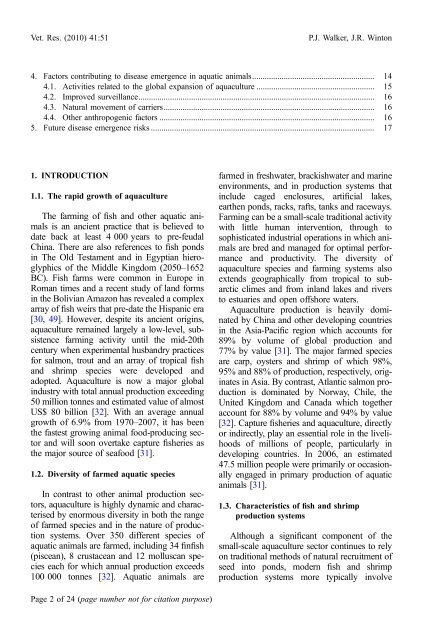Emerging viral diseases of fish and shrimp - Watershed Watch ...
Emerging viral diseases of fish and shrimp - Watershed Watch ...
Emerging viral diseases of fish and shrimp - Watershed Watch ...
You also want an ePaper? Increase the reach of your titles
YUMPU automatically turns print PDFs into web optimized ePapers that Google loves.
Vet. Res. (2010) 41:51<br />
P.J. Walker, J.R. Winton<br />
4. Factors contributing to disease emergence in aquatic animals.......................................................... 14<br />
4.1. Activities related to the global expansion <strong>of</strong> aquaculture ........................................................ 15<br />
4.2. Improved surveillance................................................................................................................ 16<br />
4.3. Natural movement <strong>of</strong> carriers.................................................................................................... 16<br />
4.4. Other anthropogenic factors ...................................................................................................... 16<br />
5. Future disease emergence risks .......................................................................................................... 17<br />
1. INTRODUCTION<br />
1.1. The rapid growth <strong>of</strong> aquaculture<br />
The farming <strong>of</strong> <strong>fish</strong> <strong>and</strong> other aquatic animals<br />
is an ancient practice that is believed to<br />
date back at least 4 000 years to pre-feudal<br />
China. There are also references to <strong>fish</strong> ponds<br />
in The Old Testament <strong>and</strong> in Egyptian hieroglyphics<br />
<strong>of</strong> the Middle Kingdom (2050–1652<br />
BC). Fish farms were common in Europe in<br />
Roman times <strong>and</strong> a recent study <strong>of</strong> l<strong>and</strong> forms<br />
in the Bolivian Amazon has revealed a complex<br />
array <strong>of</strong> <strong>fish</strong> weirs that pre-date the Hispanic era<br />
[30, 49]. However, despite its ancient origins,<br />
aquaculture remained largely a low-level, subsistence<br />
farming activity until the mid-20th<br />
century when experimental husb<strong>and</strong>ry practices<br />
for salmon, trout <strong>and</strong> an array <strong>of</strong> tropical <strong>fish</strong><br />
<strong>and</strong> <strong>shrimp</strong> species were developed <strong>and</strong><br />
adopted. Aquaculture is now a major global<br />
industry with total annual production exceeding<br />
50 million tonnes <strong>and</strong> estimated value <strong>of</strong> almost<br />
US$ 80 billion [32]. With an average annual<br />
growth <strong>of</strong> 6.9% from 1970–2007, it has been<br />
the fastest growing animal food-producing sector<br />
<strong>and</strong> will soon overtake capture <strong>fish</strong>eries as<br />
the major source <strong>of</strong> seafood [31].<br />
1.2. Diversity <strong>of</strong> farmed aquatic species<br />
In contrast to other animal production sectors,<br />
aquaculture is highly dynamic <strong>and</strong> characterised<br />
by enormous diversity in both the range<br />
<strong>of</strong> farmed species <strong>and</strong> in the nature <strong>of</strong> production<br />
systems. Over 350 different species <strong>of</strong><br />
aquatic animals are farmed, including 34 fin<strong>fish</strong><br />
(piscean), 8 crustacean <strong>and</strong> 12 molluscan species<br />
each for which annual production exceeds<br />
100 000 tonnes [32]. Aquatic animals are<br />
farmed in freshwater, brackishwater <strong>and</strong> marine<br />
environments, <strong>and</strong> in production systems that<br />
include caged enclosures, artificial lakes,<br />
earthen ponds, racks, rafts, tanks <strong>and</strong> raceways.<br />
Farming can be a small-scale traditional activity<br />
with little human intervention, through to<br />
sophisticated industrial operations in which animals<br />
are bred <strong>and</strong> managed for optimal performance<br />
<strong>and</strong> productivity. The diversity <strong>of</strong><br />
aquaculture species <strong>and</strong> farming systems also<br />
extends geographically from tropical to subarctic<br />
climes <strong>and</strong> from inl<strong>and</strong> lakes <strong>and</strong> rivers<br />
to estuaries <strong>and</strong> open <strong>of</strong>fshore waters.<br />
Aquaculture production is heavily dominated<br />
by China <strong>and</strong> other developing countries<br />
in the Asia-Pacific region which accounts for<br />
89% by volume <strong>of</strong> global production <strong>and</strong><br />
77% by value [31]. The major farmed species<br />
are carp, oysters <strong>and</strong> <strong>shrimp</strong> <strong>of</strong> which 98%,<br />
95% <strong>and</strong> 88% <strong>of</strong> production, respectively, originates<br />
in Asia. By contrast, Atlantic salmon production<br />
is dominated by Norway, Chile, the<br />
United Kingdom <strong>and</strong> Canada which together<br />
account for 88% by volume <strong>and</strong> 94% by value<br />
[32]. Capture <strong>fish</strong>eries <strong>and</strong> aquaculture, directly<br />
or indirectly, play an essential role in the livelihoods<br />
<strong>of</strong> millions <strong>of</strong> people, particularly in<br />
developing countries. In 2006, an estimated<br />
47.5 million people were primarily or occasionally<br />
engaged in primary production <strong>of</strong> aquatic<br />
animals [31].<br />
1.3. Characteristics <strong>of</strong> <strong>fish</strong> <strong>and</strong> <strong>shrimp</strong><br />
production systems<br />
Although a significant component <strong>of</strong> the<br />
small-scale aquaculture sector continues to rely<br />
on traditional methods <strong>of</strong> natural recruitment <strong>of</strong><br />
seed into ponds, modern <strong>fish</strong> <strong>and</strong> <strong>shrimp</strong><br />
production systems more typically involve<br />
Page 2 <strong>of</strong> 24 (page number not for citation purpose)
















